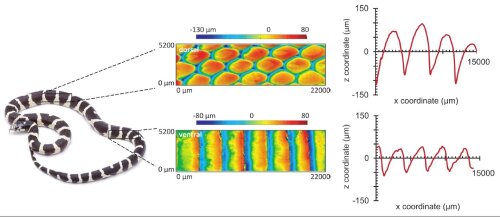Measuring Biological Surfaces in Three Dimensions
Software maps biological surfaces
The surfaces of both animals and plants can have three-dimensional
features that give them special properties: repelling water from lotus leaves,
helping geckoes walk on vertical surfaces, or snakes slide across a substrate. There
are a variety of technologies available to image these three-dimensional
structures across a wide range of sizes, but it can be difficult to accurately
quantify these surfaces.
Now an international and interdisciplinary team of engineers and biologists, including postdoctoral researcher Simon Baeckens (University of Antwerp), has developed software, called QuSTo (Quantification of Surface Topography), to do just that. “Our software is free, open source, user-friendly, and easily adaptable for specific analysis requirements, and it can be used to further research in the field of biology, ecology, and evolution as well as in bio-inspired design and engineering,” said evolutionary biologist Simon Baeckens. Studying biological surfaces could lead to new materials that mimic their properties: for example, absorbing or reflecting light, repelling or retaining moisture, showing high friction in one direction but not another.
To test their software, Alejandro Martínez, assistant professor in the Department of Civil and Environmental Engineering at UCDavis (CA, USA), and his graduate students decided to look at snake skins. Snakes show wide diversity in their skin reflecting the wide variety of habitats in which they live. Together with biologists from UMass (MA, USA) and UAntwerp, they scanned 32 snake species from the Museum of Vertebrate Zoology at UC Berkeley using a structured white light scanner and analyzed the resulting 3D data with QuSTo. They were able to quantify a wide variation in surface features among snakes, and found that some variation could be explained by where the snakes spent most of their time. Scales on the undersides of tree-climbing snakes, for example, showed most elevation, whereas snakes that burrow underground were much smoother than snakes found in other microhabitats.

The team also showed that QuSTo can be used with different imaging technologies including laser scanning, X-ray computed tomography, and photogrammetry. It is not limited in length scale so could potentially be used at from atomic scales in materials science to landscape features in earth sciences.
The work is published in Methods in Ecology and Evolution. It was supported by the NSF and FWO.
Citation: Martínez A, Nguyen D, Basson M, Medina J, Irschick DJ & Baeckens S (2021) Quantifying surface topography of biological systems from 3D scans. Methods in Ecology and Evolution doi:10.1111/2041-210X.13603.
https://besjournals.onlinelibrary.wiley.com/doi/abs/10.1111/2041-210X.13603